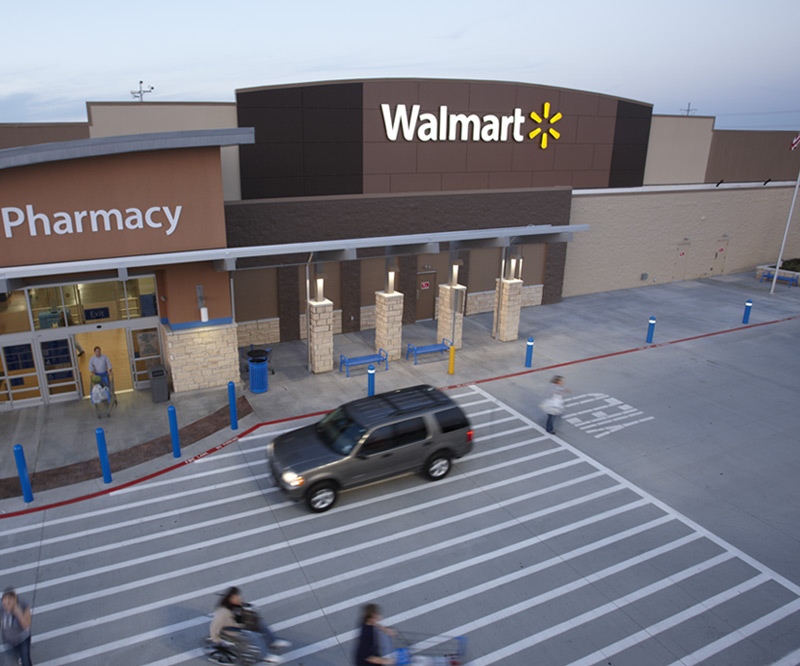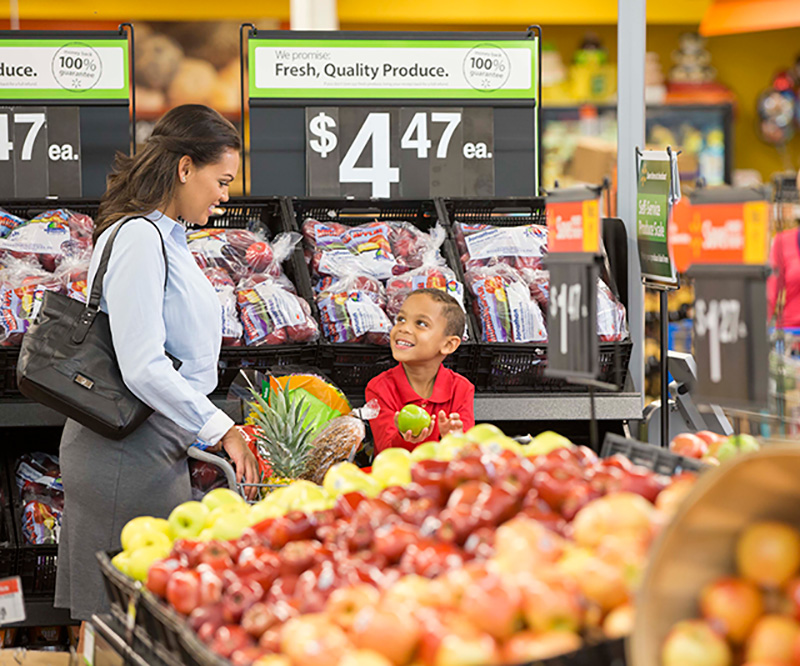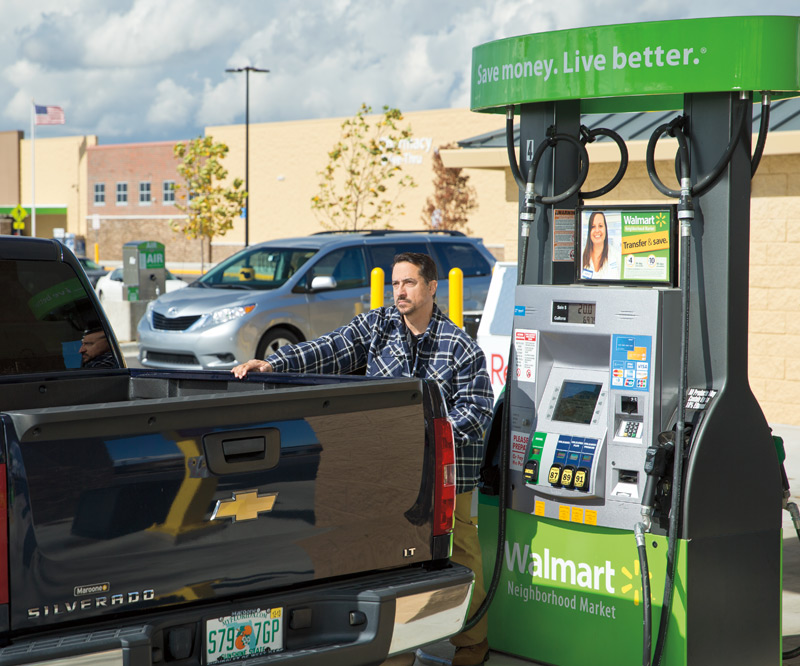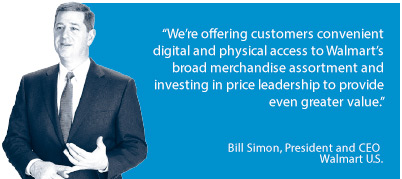140
million
customers served each week
customers served each week















In fiscal 2014, Walmart U.S. attracted nearly 140 million weekly shoppers to our stores and delivered net sales of more than $279 billion, an increase of $5 billion, or 1.8 percent, from last year. Our focus on cost discipline helped drive 4 percent operating income growth, more than twice the rate of sales, despite a 0.6 percent decline in comp sales.
Focused on customer needs. Customers choose Walmart for our broad assortment, including national brands and locally relevant merchandise, at everyday low prices (EDLP). It’s our winning formula and results in continued market share gains in key categories, such as food, consumables, over-the-counter and apparel. With our merchant mindset, we partner with suppliers to increase product innovation and bring exciting new brands to our stores, such as Russell, Avia and Calphalon. We also work hard to improve quality and execution, making great strides in areas such as produce and meat. And, our price investments are driving sales by providing a lower-priced basket relative to the market and building customers’ trust in our EDLP promise.
In order to invest in price, we focus on everyday low cost (EDLC). Advancements in logistics and store operations continue to reduce costs and improve productivity. For instance, optimized transportation routes and distribution center mechanization are driving supply chain efficiencies. Greater flexibility at the store front-end, such as selfcheckouts, is helping productivity and resonating with our customers. We believe we can drive cost savings by sourcing closer to the point of consumption. We made bold commitments to increase purchases of U.S.-made products by an additional $250 billion over the next 10 years.
Our 1.2 million associates are essential to a customer-centric experience. Advancement opportunities abound for Walmart associates who are passionate about serving customers. Last year, we promoted over 170,000 associates and experienced more part-time associates accepting full-time roles, building long-term careers with Walmart. We also added over 30,000 honorably discharged veterans to our team. We’re strengthening career development pathways by expanding training to foster continued, strong associate engagement.
Positioned to win at the convergence of digital and physical. Walmart is redefining the next generation of retail growth and is the best-positioned retailer to win at the convergence of digital and physical retail. In fiscal 2015, we’ll continue to grow our multi-format portfolio. Our core supercenter fleet serves the stock-up trip and accounts for the majority of our market share leadership. We’re accelerating the rollout of Neighborhood Markets to serve the quick-trip needs. And, our expanded pilot of Walmart Express focuses on the rural quick-trip. Neighborhood Markets and Express deliver convenience and customer access to fresh foods, pharmacy and fuel. Overall, we’ll add between 21 and 23 million retail square feet, representing between 385 and 415 units in fiscal 2015.

We’ll also connect Walmart’s physical assets to the broad assortment that is available through nearby stores and online, delivering anytime access to our brand. We’re testing grocery delivery in several markets and also piloting an easy pickup option for online grocery and general merchandise. Innovations such as these expand our reach to more customers on their terms.
Our Walmart U.S. strategy for fiscal year 2015 is centered on providing customers access to the broadest array of products through a digitally connected, multi-format portfolio. Supercenters continue to play an important role in carrying out our growth agenda, but we are also accelerating our investment in opening smaller stores – Neighborhood Markets and Walmart Express.
Our research shows that the typical U.S. consumer makes different kinds of shopping trips that can range from a stock-up trip to purchase large amounts of merchandise to a fill-in trip for just a few items. Walmart supercenters are essential in meeting customer needs as a one-stop shop for groceries, general merchandise, and other categories during stock-up trips. Supercenters have continued to deliver the strongest returns within Walmart and remain among retail’s most productive locations.
The quick trip, fill-in or mid-week shopping trip represents an approximately $400 billion market or approximately 40 percent of all grocery spending. Walmart has a great opportunity to serve customers more frequently with our smaller format stores to deliver convenience. During fiscal 2014, net sales for Neighborhood Markets grew by about 40 percent and comp sales increased approximately 4 percent. These results were comparable to or exceeded those of our leading grocery competitors. And, it’s worth noting that Neighborhood Market sales per square foot top those of other major grocery chains.
Neighborhood Markets — A Well-Differentiated, Hybrid Format
Neighborhood Markets have been very effective in rural and suburban settings and they compete well against a wide variety of formats. It’s a store with a diverse offering that no competitor can match – Walmart’s everyday low prices on an assortment of about 25,000 SKUs, including fresh food and pharmacy. Moving forward, the goal is to have fuel offered in all new stores. These unique offerings are further enhanced by connectivity to our full assortment on walmart.com, which we believe to be a competitive advantage. Internal data shows that when we launch a new Neighborhood Market, we capture new sales dollars, new trips and new customers, without cannibalization to nearby supercenters.
Walmart Express — Expanding learnings to maximize the potential
In fiscal 2015, we’re expanding the 20-unit pilot of our Walmart Express store format to continue to refine the model and better understand how it can best serve customers, with focus on the rural quick-trip. Our goal is to add 100 new Walmart Express stores this year. Smaller than Neighborhood Markets, the Walmart Express format offers approximately 10,000 SKUs in its merchandise assortment and includes traffic-driving services such as fuel, pharmacy and fresh foods. Our best results have come from stores located in rural and suburban areas. Like Neighborhood Markets, each Walmart Express is connected to the full Walmart distribution and e-commerce network, which vastly expands the merchandise assortment available to customers.
Next Steps
In fiscal 2014, we added 105 Neighborhood Markets, bringing our fleet to 346 total units. We also opened 7 Walmart Express stores, bringing total units to 20 stores. We have improved our speed to market and reduced our capital costs, and in fiscal 2015, we expect to add approximately 300 new small stores – comprised of 200 Neighborhood Markets and 100 Walmart Express stores. Our customers’ needs and expectations are changing. We believe these stores provide convenience and easy access to fresh foods, pharmacy and fuel. And, through services like Site to Store, Pay with Cash, and Scan & Go, we marry the digital and physical experience for customers.